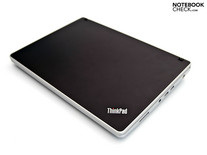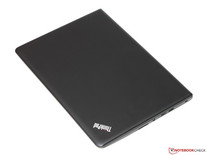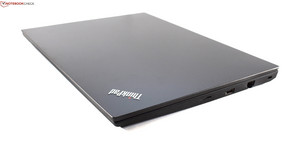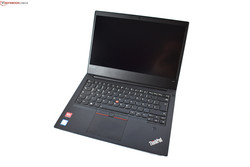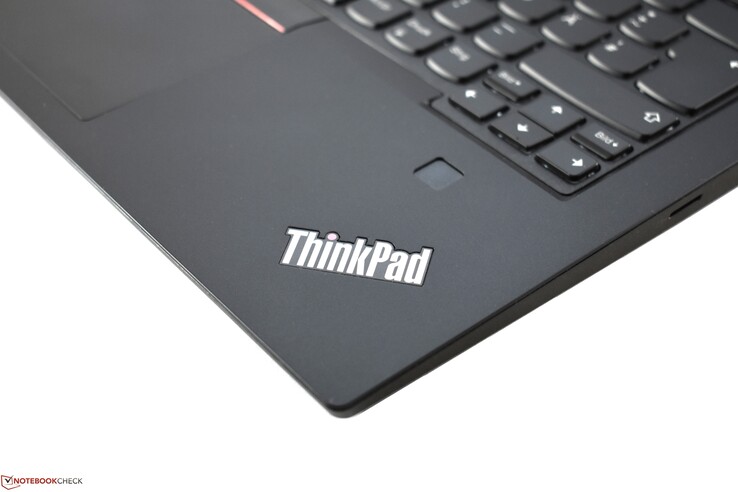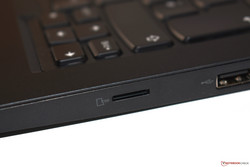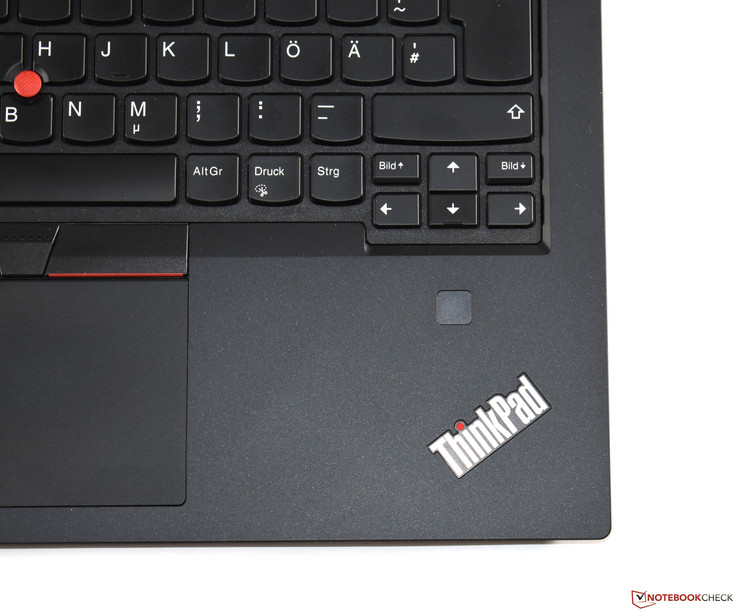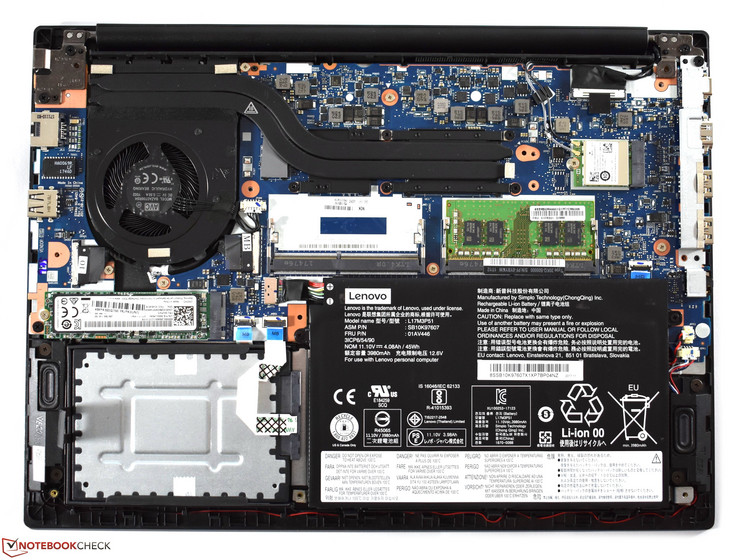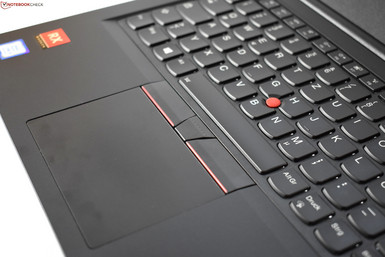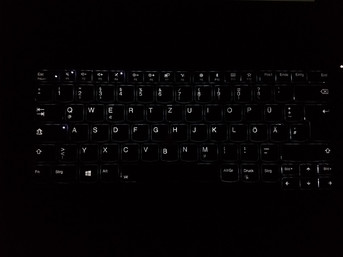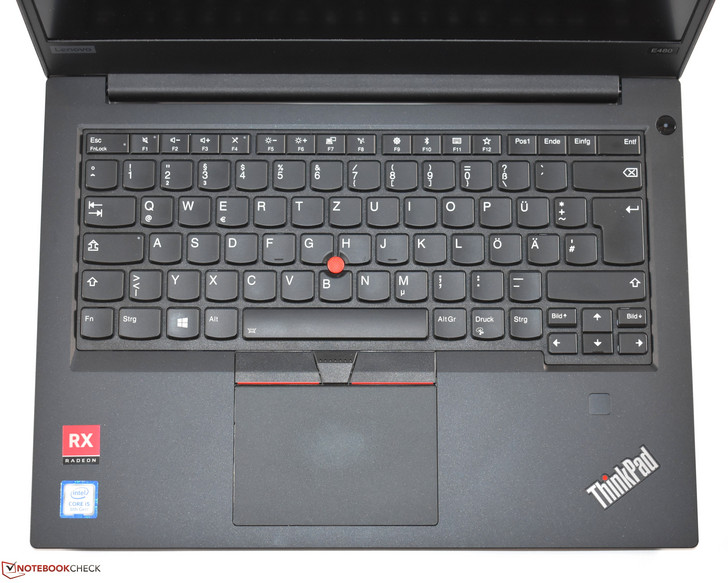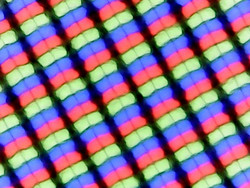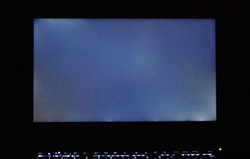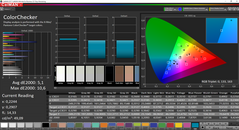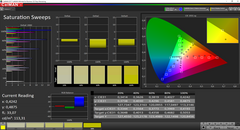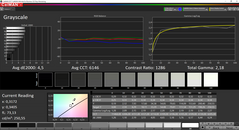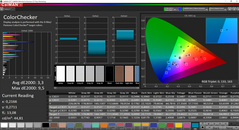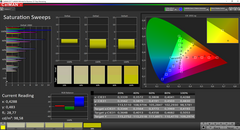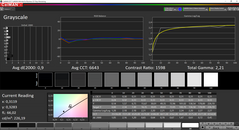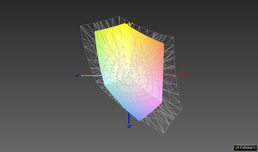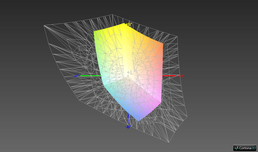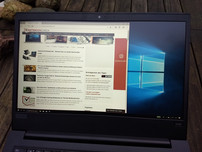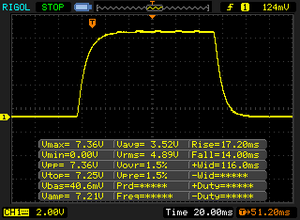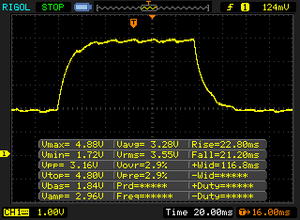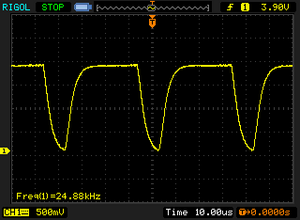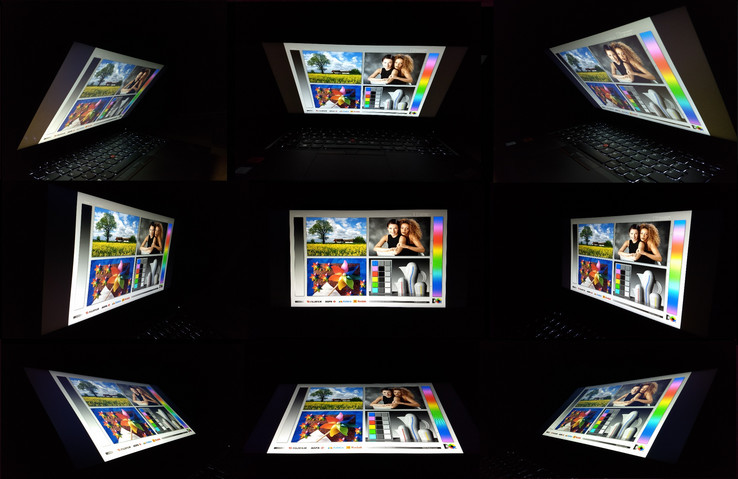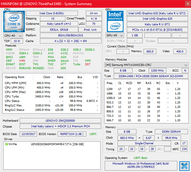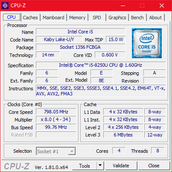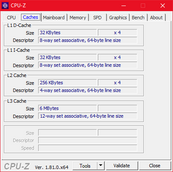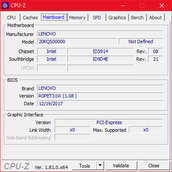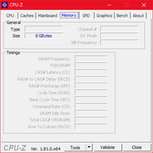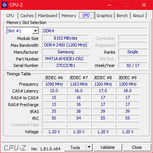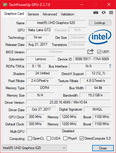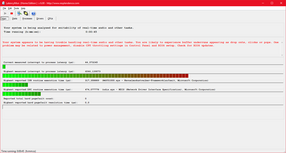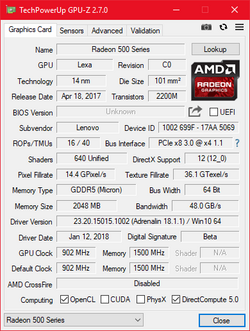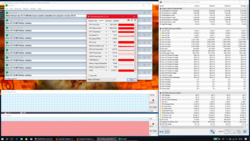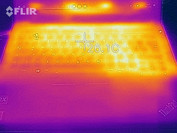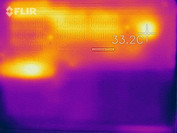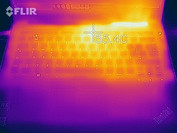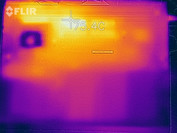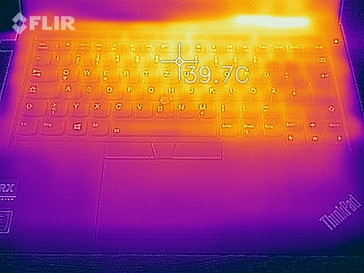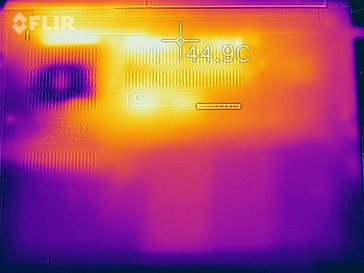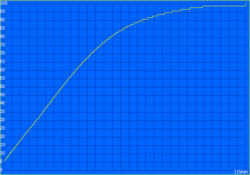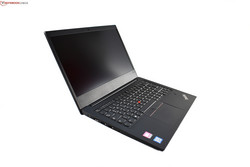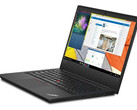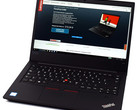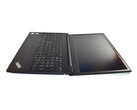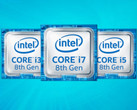ThinkPad E480 (i5-8250U, RX 550) Laptop Review
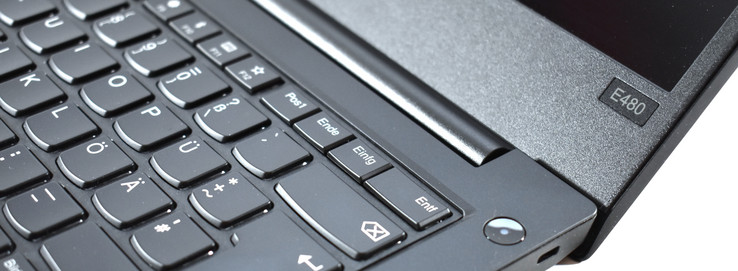
With the E480 and E580 models, Lenovo's ThinkPad E-series now enters the eighth generation. It was launched in 2010 as the Edge series, which at that time was meant to bring a breath of fresh air with its - for ThinkPad standards - unorthodox design. Since then, the Edge and E-Series have taken on the role of the entry-level ThinkPad.
It has been a tradition for some time now that the E-Series is always the first ThinkPad series with the latest processors. This year, the E480 and E580 are pioneers in the transition from dual-core to quad-core processors. Our smaller test model, the E480, is the first ThinkPad with the new "Kaby-Lake-Refresh" CPUs that made it into our labs. However, it is not the first business-oriented notebook with the new processors: HP launched its ProBook 440 G5 at the end of 2017. However, as we have not yet been able to test this model, we have to use the predecessor as a reference device (HP ProBook 440 G4). There is a similar situation with Dell, but we have to use the even older Latitude 14 3470 model, which still contains Skylake CPUs. With Acer's competitor TravelMate P449, we have tested the Kaby-Lake version. There is no model with Acer's Quad-Core CPUs yet. The comparison with the predecessor ThinkPad E470 is of course mandatory.
Our test device is a campus model with the model number 20KQS00000, which, in this form, is only available for students and other authorized users in Lenovo's campus program. You get a Core i5 with 256 GB SSD, 8 GB RAM and the optional AMD Radeon RX 550 for 739 Euros (~$920). Windows is not pre-installed, because many students are provided with the operating system by the university. You can buy the E480 in the same configuration with Windows 10 Home for about 810 Euros (~$1000) in the Lenovo online shop.
Update BIOS 1.14: Lenovo wants to improve the temperature development with BIOS 1.14. We checked that and repeated our stress test. We also repeated some benchmarks to see if there are any effects in terms of performance. We updated the sections GPU Performance as well as Gaming Performance.
Case
As already mentioned in the introductory text, the Edge series started out as an antithesis to the typical ThinkPad design: The first generation of this new series with models like the ThinkPad Edge 13 came with design attributes such as a silver band, round corners and an optional glossy red display cover. Over the course of generations, Lenovo has gradually discarded these design features, which do not really fit into a ThinkPad notebook (after all... the epitome of seriousness). In the ThinkPad E470, only the rounded corners were left.
The ThinkPad E480 is the visual end of this development. The rounded corners and edges give way to a more angular, rectangular design with clear lines, which looks much more sophisticated than the somewhat clumsy predecessor. E470's design communicated its status as a budget series much more clearly to the outside world than the E480 design. This is also due to the smaller display edges of the E480, which have only shrunk at the top and at the sides - towards the bottom the edge has become even larger, which may be a hint to the price positioning of the ThinkPad.
With the case materials, Lenovo is changing from a coated plastic lid to a black-finished aluminum display cover. The base unit is made of black plastic with a smooth coating in the palm rest area. The display frame and the underside are made of brushed plastic. Optionally, the E480 is also available in a silver color.
Although the wrist-rest is made of plastic, it is reinforced with aluminum. This also explains the very good stability of the entire keyboard area, which cannot be pressed anywhere - not even in the middle, where many other notebooks have a weak point. The aluminum absorbs pressure on the back of the display relatively well, but with strong pressure you can see effects on the panel. When pressure is applied the base can only be twisted very slightly, but the display cover is more flexible at this point. However, ABS plastic display covers are typically much more unstable, so we criticize them at a high level. The workmanship, which is flawless with our test device, is above criticism.
We are familiar with the wide mono hinge from the ThinkPad E470. It is very well adjusted on the E480 because it is possible to open the display with one hand while the display hardly wobbles. In the past, ThinkPad E-Series displays could only be opened up to 135°, but the E480's mono hinge allows the ThinkPad's typical opening angle of 180°.
Compared to its own predecessor, the E480 has slimmed down - it is 100 grams (~3.5 oz) lighter, almost 4 mm (~0.16 in) thinner and slightly less wide, resulting in smaller lateral display edges.
In the category of the E480 (affordable business notebooks) all comparable devices have a weight of about 1.8 kg. Higher-priced business models such as the ThinkPad T series, the Dell Latitude 7000 series or the HP EliteBook 840 series of the same size are often several hundred grams lighter since their cases are made of more expensive and lighter materials.
Connectivity
We have criticized the predecessor E470 for the lack of USB Type-C. With the E480, on the other hand, USB-C plays a central role, as the proprietary Lenovo slim tip charging port is no longer needed for the USB Type-C connection. Accordingly, Lenovo now relies on USB Type-C for charging. The USB Type-C connector cannot only be used for charging, it also transmits display port and it can handle USB 3.1-Gen-2, which offers twice the transfer rate compared to USB 3.0 or USB 3.1-Gen-1.
Especially the display port function is a big step forward compared to the E470, because the E470 only had one HDMI port, which could output a maximum of 1920x1080 in 60 Hz. It should also be possible to operate a UHD monitor (3840x2160) at 60 Hz with the E480. The USB Type-C connector is still missing Thunderbolt though. However, since the E480 is still a budget device, we can put up with this absent feature.
Apart from the introduction of USB Type-C and MicroSD card readers, the connectivity has not changed much. You could also criticize that Lenovo only uses USB 2.0 speed for one of the three USB Type-A ports - this should no longer happen in 2018. Also annoying is that the two USB 3.0 ports are located on the left, leaving the lonely USB 2.0 port on the right. Therefore, if you want fast transfer rates, you have to connect the peripheral device on the left. The E470 had a better solution for that. Otherwise, the port positioning was successful because all connections are located in the back of the side panels, so mouse users should not have any problems.
SD Card Reader
The second major change in connectivity, apart from USB Type-C, concerns the card reader: Lenovo swapped a full-size SD card slot for a microSD card slot. An inexplicable change, after all, the case is more than spacious enough for a normal SD card reader. The current competitors in the form of the HP ProBook 440 G5 and the Dell Latitude 3490 still have full-size SD card slots, so the E480 is clearly lagging behind.
The measured performance of the MicroSD card slot is at an average level. The benchmarks were performed with the Toshiba Exceria Pro M501 MicroSD Reference Memory Card.
| SD Card Reader | |
| average JPG Copy Test (av. of 3 runs) | |
| Lenovo ThinkPad E480-20KQS00000 (Toshiba Exceria Pro M501) | |
| HP ProBook 440 G4-Y8B51EA (Toshiba Exceria Pro SDXC 64 GB UHS-II) | |
| Lenovo ThinkPad E470-20H2S00400 (Toshiba Exceria Pro SDXC 64 GB UHS-II) | |
| Acer TravelMate P449-G2-M-56CD (Toshiba Exceria Pro SDXC 64 GB UHS-II) | |
| Dell Latitude 14 3470 (Toshiba Exceria Pro SDXC 64 GB UHS-II) | |
| maximum AS SSD Seq Read Test (1GB) | |
| HP ProBook 440 G4-Y8B51EA (Toshiba Exceria Pro SDXC 64 GB UHS-II) | |
| Lenovo ThinkPad E480-20KQS00000 (Toshiba Exceria Pro M501) | |
| Lenovo ThinkPad E470-20H2S00400 (Toshiba Exceria Pro SDXC 64 GB UHS-II) | |
| Dell Latitude 14 3470 (Toshiba Exceria Pro SDXC 64 GB UHS-II) | |
| Acer TravelMate P449-G2-M-56CD (Toshiba Exceria Pro SDXC 64 GB UHS-II) | |
Communication
More expensive business laptops typically rely on current Intel solutions such as the Intel Wireless 8265 for their communication modules. As a budget device, the E480 does not offer this option; instead, there is the Intel Wireless 3165, the Realtek 8821CE or the Realtek 8822BE. Only the latter card is a 2x2 AC module, while the other options are restricted to 1x1 AC WLAN. Our test device contains the 2x2-card Realtek RTL8822BE, which delivered a faultless performance in both benchmarks and everyday use. The built-in Gigabit Ethernet module (RTL8168/8111) also comes from Realtek. The E480 does not offer WWAN options.
Webcam and microphones are the usual laptop standard fare that is sufficient for video telephony, but not more than that.
| Networking | |
| iperf3 transmit AX12 | |
| Acer TravelMate P449-G2-M-56CD | |
| Lenovo ThinkPad E480-20KQS00000 | |
| Lenovo ThinkPad E470-20H2S00400 | |
| iperf3 receive AX12 | |
| Lenovo ThinkPad E480-20KQS00000 | |
| Lenovo ThinkPad E470-20H2S00400 | |
| Acer TravelMate P449-G2-M-56CD | |
Security
Although the E480 is a business notebook, Lenovo says it will be best for smaller companies. Therefore, the E480 does not have all the security features found in the Enterprise ThinkPads of the T or L series. Remarkable, for example, is the missing smartcard slot.
However, there is a basic set of security features. In addition to TPM 2.0, this also includes a touch-based fingerprint reader placed between the keyboard and the ThinkPad logo in the wrist-rest. This fingerprint reader works just as well as with the other ThinkPads. Unlike the more expensive ThinkPads, the reader does not have a status LED that signals to the user when the fingerprint sensor is ready.
Accessories
Accessories are not included with the E480. The ThinkPad USB-C-Dock, which Lenovo is offering in Germany for around 230 Euros (~$285), is probably the most important optional accessory. This dock is somewhat cheaper for about 150 Euros (~$185) in the campus program
Maintenance
The E480 has a structure that we often find in the form of Ultrabooks: To access the components, the entire underside must be removed. To do this, you first have to loosen nine screws and then several plastic clips. For the clips you should use a plastic Pry-Up-Tool, alternatively, you could use a credit card. The user should proceed with great caution, because otherwise you might destroy a clip and damage the case.
After overcoming this obstacle, you have access to most components. Of course, the battery, which is not glued but screwed down, and the cooling system are important. The E480 can also be upgraded, for example by installing a larger M.2 SSD or by retrofitting a second RAM module. The 2.5-inch slot for an SSD/HDD is equipped with a dummy in our model, but the cable and connection seem to be present.
It is worth mentioning that the E480's keyboard is also very easy to swap. To do this, remove the right and left TrackPoint buttons and loosen two screws located below the buttons.
Warranty
Lenovo sells the ThinkPad E480 with a bring-in warranty of only 12 months. This is less than with many notebooks for private customers in the same price range. However, all competitors also come with a standard warranty of only 12 months. For an additional charge, the warranty can be extended by three years to up to 48 months and additional services such as on-site service and accident protection can be purchased. For example, a 36-month guarantee with accident protection costs more than 220 Euros (~$275), while students and other beneficiaries of the Campus program can purchase this guarantee package for about 160 Euros(~$200).
Please see our Guarantees, Return Policies and Warranties FAQ for country-specific information.
Input devices
Keyboard
ThinkPads are known for their outstanding keyboards. The E-Series has also been equipped with consistently good keyboards in the past, although the quality was slightly lower than the more expensive models. In addition, the E-Series has never before been available with backlit keyboards.
E480 & E580 are the first models of the E-series with an optional illuminated keyboard (white backlit, two-stage). Not only that, the keyboard is also qualitatively absolutely on par with the T-series. At least with our test device - Lenovo usually has several suppliers for the keyboards, so that fluctuations in quality cannot be ruled out. The keys of our Chicony keyboard have a smooth feel, a sufficiently large stroke (about 1.8 mm) and a crisp pressure point. In addition, the keyboard cannot be pressed in even when typing hard. The keys have exactly the right resistance, resulting in an excellent typing feel. The E480 is suitable for prolific typists.
The full-size keyboard has the typical six-row layout used on all ThinkPads since 2012. Although the seven-row layout of the ThinkPad 25 might still be the only true keyboard layout for purists, the six-row ThinkPad layout is definitely one of the better modern notebook layouts. The arrow keys are not squeezed together, the F keys are grouped and navigation keys such as Home, End and Page Up/Down are available as independent keys.
Mouse substitute
Touchpad and TrackPoint buttons have been reworked in the style of the T470. The TrackPoint keys were moved to the keyboard. As a result, and by omitting an unused area between the TrackPoint buttons and the touchpad surface, the touchpad has grown a little bit, it now measures 10 x 6.8 cm (~0.39 x 0.27 inches, instead of 10 x 5.6 cm as in the E470).
The touchpad itself is a ClickPad with integrated buttons and a plastic surface. This is sufficiently smooth, but by far not as high quality as a glass TrackPad. Likewise, the click mechanism is not perfect. Although the clicks are not loud and rather dull, we do not like the undefined pressure point and the somewhat too high resistance. All in all, the touchpad hardware is acceptable, but not really outstanding. There is nothing wrong with the software though. Lenovo relies on the Microsoft precision driver, which also perfectly implements multitouch gestures.
In addition, as with almost all ThinkPads, there is the red TrackPoint between the B-G-H keys. This works perfectly and, in combination with the crisp TrackPoint buttons, is an excellent alternative to the touchpad.
Display
The E480 is offered with two display options: The basic option is an HD screen (1366x768) which is a TN panel. This LCD should definitely be avoided. Our test device contains the second option: A Full HD IPS screen with a resolution of 1920x1080. All displays built into the E480 are matte and without touch-options.
As with the keyboards, there are often different panel manufacturers for the displays. In the case of the E480 there are screens from AUO, BOE and Innolux. The E480 test device has an Innolux panel, just like its predecessor ThinkPad E470 and the parallels go even further: According to the specifications, both E470 and E480 are supposed to offer a display brightness of 250 cd/m², but with an average of 231 cd/m², they do not achieve this value. The E480 achieves at least a maximum brightness of 251 cd/m² in the middle segment of the display. All the other competitors also have mediocre displays, although the HP ProBook 440 G4 is even worse with its dark Full HD-TN panel. However, the current model of this series, the ProBook 440 G5, now has a Full HD IPS option.
Our test device has an illuminance of 80% - a mediocre value, but at least no shadowing is visible to the naked eye. Backlight bleeding is rarely present. Our measuring instruments were able to detect pulse width modulation, but the frequency is so high that it should be harmless for users that are more sensitive.
| |||||||||||||||||||||||||
Brightness Distribution: 80 %
Center on Battery: 253 cd/m²
Contrast: 1321:1 (Black: 0.19 cd/m²)
ΔE ColorChecker Calman: 5.1 | ∀{0.5-29.43 Ø4.78}
ΔE Greyscale Calman: 4.5 | ∀{0.09-98 Ø5}
62.5% sRGB (Argyll 1.6.3 3D)
39.8% AdobeRGB 1998 (Argyll 1.6.3 3D)
43.29% AdobeRGB 1998 (Argyll 3D)
62.8% sRGB (Argyll 3D)
41.88% Display P3 (Argyll 3D)
Gamma: 2.18
CCT: 6146 K
| Lenovo ThinkPad E480-20KQS00000 Innolux N140HCA-EAC, , 1920x1080, 14" | Lenovo ThinkPad E470-20H2S00400 N140HCA-EAB, , 1920x1080, 14" | HP ProBook 440 G4-Y8B51EA AUO1E3D, , 1920x1080, 14" | Acer TravelMate P449-G2-M-56CD N140HCA-EAB, , 1920x1080, 14" | Dell Latitude 14 3470 Innolux N140BGE, , 1366x768, 14" | |
|---|---|---|---|---|---|
| Display | -2% | -10% | -2% | -4% | |
| Display P3 Coverage (%) | 41.88 | 41.23 -2% | 37.6 -10% | 41.04 -2% | 40.21 -4% |
| sRGB Coverage (%) | 62.8 | 61.4 -2% | 56.6 -10% | 61.2 -3% | 60.5 -4% |
| AdobeRGB 1998 Coverage (%) | 43.29 | 42.67 -1% | 38.85 -10% | 42.47 -2% | 41.55 -4% |
| Response Times | 5% | 12% | 11% | 5% | |
| Response Time Grey 50% / Grey 80% * (ms) | 44 ? | 40.8 ? 7% | 43.2 ? 2% | 39 ? 11% | 47 ? -7% |
| Response Time Black / White * (ms) | 31.2 ? | 30.4 ? 3% | 24.4 ? 22% | 28 ? 10% | 26 ? 17% |
| PWM Frequency (Hz) | 24880 ? | 25000 ? | |||
| Screen | -22% | -48% | -16% | -61% | |
| Brightness middle (cd/m²) | 251 | 244 -3% | 216 -14% | 271 8% | 206 -18% |
| Brightness (cd/m²) | 231 | 231 0% | 203 -12% | 256 11% | 193 -16% |
| Brightness Distribution (%) | 80 | 89 11% | 83 4% | 85 6% | 87 9% |
| Black Level * (cd/m²) | 0.19 | 0.37 -95% | 0.47 -147% | 0.43 -126% | 0.48 -153% |
| Contrast (:1) | 1321 | 659 -50% | 460 -65% | 630 -52% | 429 -68% |
| Colorchecker dE 2000 * | 5.1 | 6.41 -26% | 8.98 -76% | 5.03 1% | 11 -116% |
| Colorchecker dE 2000 max. * | 10.6 | 13.4 -26% | 14.07 -33% | 11.9 -12% | 19.57 -85% |
| Greyscale dE 2000 * | 4.5 | 5.94 -32% | 9.61 -114% | 4.02 11% | 11.51 -156% |
| Gamma | 2.18 101% | 2.28 96% | 2.63 84% | 2.31 95% | 2.23 99% |
| CCT | 6146 106% | 6101 107% | 11265 58% | 6659 98% | 13671 48% |
| Color Space (Percent of AdobeRGB 1998) (%) | 39.8 | 39.3 -1% | 35.9 -10% | 39 -2% | 38.46 -3% |
| Color Space (Percent of sRGB) (%) | 62.5 | 61.1 -2% | 56.7 -9% | 61 -2% | 60.61 -3% |
| Total Average (Program / Settings) | -6% /
-15% | -15% /
-32% | -2% /
-10% | -20% /
-41% |
* ... smaller is better
The contrast of the built-in display is much better than that of all competitors. At 1321:1, it is more than twice as high as the reference units, which all range from about 450:1 to 650:1. This good value results from the low black value (0.19 cd/m²). The comparatively high contrast is definitely one reason why the picture quality of the display is subjectively good. There is a slight yellowish tint ex works, but this can be quickly removed with a calibration. As always, the matching ICC color profile is provided free of charge by Notebookcheck.
Typical for the price range of the E480 or the class of the cheap business notebooks is the low color space coverage, which is equally bad with all competitors. With only 62.5% of the sRGB color space, the display is not suitable for image processing at all.
Display Response Times
| ↔ Response Time Black to White | ||
|---|---|---|
| 31.2 ms ... rise ↗ and fall ↘ combined | ↗ 17.2 ms rise | |
| ↘ 14 ms fall | ||
| The screen shows slow response rates in our tests and will be unsatisfactory for gamers. In comparison, all tested devices range from 0.1 (minimum) to 240 (maximum) ms. » 84 % of all devices are better. This means that the measured response time is worse than the average of all tested devices (20.2 ms). | ||
| ↔ Response Time 50% Grey to 80% Grey | ||
| 44 ms ... rise ↗ and fall ↘ combined | ↗ 22.8 ms rise | |
| ↘ 21.2 ms fall | ||
| The screen shows slow response rates in our tests and will be unsatisfactory for gamers. In comparison, all tested devices range from 0.165 (minimum) to 636 (maximum) ms. » 72 % of all devices are better. This means that the measured response time is worse than the average of all tested devices (31.6 ms). | ||
Screen Flickering / PWM (Pulse-Width Modulation)
| Screen flickering / PWM detected | 24880 Hz | ≤ 40 % brightness setting | |
The display backlight flickers at 24880 Hz (worst case, e.g., utilizing PWM) Flickering detected at a brightness setting of 40 % and below. There should be no flickering or PWM above this brightness setting. The frequency of 24880 Hz is quite high, so most users sensitive to PWM should not notice any flickering. In comparison: 53 % of all tested devices do not use PWM to dim the display. If PWM was detected, an average of 8118 (minimum: 5 - maximum: 343500) Hz was measured. | |||
Performance
As usual with ThinkPads, the E480 is not only offered in fixed configurations, but also freely configurable in Lenovo's own web store. Prices here start at just under 590 Euros (~$735). In the most expensive configuration the E480 costs 1,209 Euros (~$1,500). The fixed configurations cover a smaller price range (744 to 897 Euros / ~$925 to $1,115). In addition, there are also two special campus configurations for about 739 or 989 Euros (~$920 - $1,230).
You can choose between Intel Core i5-8250U and Core i7-8550U processors. The Intel UHD Graphics 620 is always available, with the AMD Radeon RX 550 supplementing it, depending on the model. The E480 can contain both SSDs and HDDs, with the SSDs having a capacity of 128, 256 or 512 GB. The hard disks have either 500 GB or 1 TB. Hard disks and SSDs are combinable, so you can also use a small SSD with a large hard drive. With RAM, up to 32 GB of DDR4-2400 memory is possible, as the E480 has two SO-DIMM slots. The cheapest configuration contains 4 GB of RAM. Most configurations, including our test device, offer twice the amount of memory with 8 GB RAM.
Exclusively available in the Lenovo shop, for example, is the HD display option and the silver color option. If you want to use an E480 without Windows, you have to choose one of the two campus configurations.
Processor
With the i5-8250U, our test device contains the cheaper of the two CPU options. The i5-8250U is a 14 nanometer chip from the latest generation of Kaby-Lake Refresh chips, marketed by Intel as the "Eighth Generation of Core i CPUs". Compared to its direct predecessor, the Core i5-7200U, the i5-8250U has two more cores, making it a quad-core processor. The four cores clocked with 1.6 GHz (basic clock) or 3.4 GHz in turbo. Comparisons with other processors are possible via our CPU benchmark list.
In the E480, the CPU never reaches the maximum clock rate of 3.4 GHz in the Cinebench multi-core test. At the beginning of the test, the clock rate is 2.9 GHz, which means that the CPU is allowed to consume about 25 watts. After a few seconds, the CPU temperature reaches 78 °C (172.4 °F) and the clock rate drops to 2.3 GHz. At the same time, consumption drops to 15 W. This behavior also explains the result in the Cinebench multi-core loop. The higher clock rate is only available in the first run; otherwise, the CPU remains at 2.3 GHz, resulting in a lower score of just over 500 points.
Compared to its predecessor models, the E480 clearly outperforms them in terms of performance. The ThinkPad E470 with the Core i5-7200U is 66% slower in the multi-core test, compared to 11% in the single-core test. However, the E480 does not offer an ideal utilization of the power reserves. The same CPU in the ProBook 470 G5 is another 10% faster in the multi-core test. With the new XPS 13 9370 the processor is even 16% faster.
CPU performance is not reduced in battery operation.
System Performance
In the PCMark benchmarks, the ThinkPad E480 occupies the top position, which is undoubtedly related to the quad-core processor. Surprisingly, however, this is not fully reflected in everyday life. Most of the time the system is fast, but sometimes short hangs occur. Since the E480 is brand new hardware, we assume that there may be a driver problem - or that the SSD is causing the problem.
| PCMark 10 | |
| Digital Content Creation | |
| Lenovo ThinkPad E480-20KQS00000 | |
| Acer TravelMate P449-G2-M-56CD | |
| Productivity | |
| Lenovo ThinkPad E480-20KQS00000 | |
| Acer TravelMate P449-G2-M-56CD | |
| Essentials | |
| Lenovo ThinkPad E480-20KQS00000 | |
| Acer TravelMate P449-G2-M-56CD | |
| Score | |
| Lenovo ThinkPad E480-20KQS00000 | |
| Acer TravelMate P449-G2-M-56CD | |
| PCMark 8 Home Score Accelerated v2 | 4187 points | |
| PCMark 8 Work Score Accelerated v2 | 5189 points | |
| PCMark 10 Score | 3954 points | |
Help | ||
Storage Devices
As we looked for the model number of the SSD built into the E480, we found a little surprise: The SSD with the model number LENSE20256GMSP34MEAT2TA is produced by Lenovo itself.
This proprietary Lenovo product is a PCIe NVMe SSD in M. 2-2280 format with a capacity of 256 GB. The test results in the storage benchmarks are weak: The SSD is fast in sequential read testing, but otherwise it is an NVMe-PCIe SSD of the slowest kind. So slow, even the SATA III SSD in the ThinkPad E470 is sometimes considerably faster. The Latitude 14 3470 is even slower - but that was also a hard disk in this test device.
| Lenovo ThinkPad E480-20KQS00000 Lenovo LENSE20256GMSP34MEAT2TA | Lenovo ThinkPad E470-20H2S00400 SanDisk X400 SED 256GB, SATA (SD8TB8U-256G) | Dell Latitude 14 3470 Toshiba MQ01ACF050 | HP ProBook 440 G4-Y8B51EA SanDisk SD8SNAT256G1002 | Acer TravelMate P449-G2-M-56CD Intel SSD 600p SSDPEKKW512G7 | |
|---|---|---|---|---|---|
| CrystalDiskMark 3.0 | 31% | -88% | 13% | 116% | |
| Read Seq (MB/s) | 1295 | 476.5 -63% | 108.9 -92% | 491.2 -62% | 1086 -16% |
| Write Seq (MB/s) | 160.6 | 458.7 186% | 103.2 -36% | 322.2 101% | 581 262% |
| Read 512 (MB/s) | 872 | 346.4 -60% | 310.1 -64% | 869 0% | |
| Write 512 (MB/s) | 122 | 291.1 139% | 276 126% | 584 379% | |
| Read 4k (MB/s) | 25.72 | 35.15 37% | 0.362 -99% | 19.57 -24% | 35.89 40% |
| Write 4k (MB/s) | 95.2 | 78.8 -17% | 0.946 -99% | 77.8 -18% | 122.4 29% |
| Read 4k QD32 (MB/s) | 389.9 | 276 -29% | 0.721 -100% | 146.3 -62% | 462.9 19% |
| Write 4k QD32 (MB/s) | 118.3 | 178.3 51% | 0.901 -99% | 241.4 104% | 370.9 214% |
Graphics card
The AMD Radeon RX 550 is a mid-range graphics chip of the Polaris architecture, which was released in March 2017. As a dedicated GPU, it comes with its own memory (2 GB GDDR5). It has 640 shader units, which, according to AMD, clock with a maximum of 1476 MHz. For comparisons with other GPUs you can use the GPU benchmark list.
The specified maximum clock rate of 1476 MHz is only the theoretically possible value - after all, the performance depends on how much the GPU is allowed to consume and how well it is cooled. With the E480, the graphics chip achieves a maximum clock rate of 902 MHz, whereby it can consume about 20 to 25 watts.
The performance of the RX 550 in the E480 is roughly on par with the Nvidia GeForce MX150 in the Xiaomi Notebook Pro, one of the faster implementations of the MX150. Compared to the GeForce 940MX in its predecessor, the Radeon RX 550 is already a significant leap forward, and in the Firestrike test it is 85% faster.
The performance of the graphics chip is limited in battery operation. The maximum clock rate here is only 547 MHz, which means that the E480 in the 3DMark11 only reaches 3100 instead of 4748 points.
Update BIOS 1.14: Lenovo reduced the GPU performance dramatically to improve the temperatures. We added the new 3DMark 11 GPU score in the table below and also listed the iGPU SKU of the E480 for comparison. The discrete Radeon is actually just ahead of the integrated Intel GPU.
| 3DMark 11 Performance | 4748 points | |
| 3DMark Cloud Gate Standard Score | 8755 points | |
| 3DMark Fire Strike Score | 2759 points | |
Help | ||
Gaming Performance
The E480 is not a gaming notebook, but PC games are possible. Newer titles are playable, but the details and resolution have to be reduced. The E480 is much more suitable for games than the E470. However, a comparison with the HP Pavilion Power 15t using the same GPU shows that the potential of the graphics chip is actually much higher.
Update BIOS 1.14: The performance reduction in the synthetic benchmarks is translated to the real-world gaming tests as well. While the E480 originally managed smooth 73.5 FPS in Bioshock Infinite (High setting), the value is now just 21.9 FPS after the update. This is once again just slightly ahead of the iGPU.
| BioShock Infinite - 1366x768 High Preset | |
| Microsoft Surface Book 2 | |
| HP Pavilion Power 15t-cb2000 | |
| Lenovo ThinkPad E480-20KQS00000 | |
| Lenovo ThinkPad E480-20KQS00000 (BIOS 1.14) | |
| Lenovo ThinkPad E470-20H2S00400 | |
| Lenovo ThinkPad E480-20KNCTO1WW | |
| low | med. | high | ultra | |
|---|---|---|---|---|
| BioShock Infinite (2013) | 159.4 | 90.7 | 21.9 | 22.35 |
| The Witcher 3 (2015) | 53.8 | 34.04 | 17.34 | |
| Civilization 6 (2016) | 59.8 | 48.74 | 24.04 |
Emissions
System Noise
Notebooks with Ultrabook processors can often be run silently under low load. This is not the case with the E480. The fan starts up often, even when idle. The fan is also clearly audible under load and the fan noise is rather unpleasant because it is very high frequency. The predecessor E470 was a much quieter notebook.
Update BIOS 1.14: The fan is much quieter with the new BIOS and we never measure more than ~33 dB(A) even under load, so the laptop is comparable to the iGPU SKU.
Noise level
| Idle |
| 29.8 / 31.5 / 33.3 dB(A) |
| Load |
| 39.1 / 40.4 dB(A) |
 | ||
30 dB silent 40 dB(A) audible 50 dB(A) loud |
||
min: | ||
Temperature
The E470 reached 53 °C (127.4 °F) on the underside under load. The E480 has a thinner case and more powerful hardware - what could possibly go wrong? As it turns out, a lot. The cooling system is not up to the components at all and this manifests itself in extremely high outside temperatures. In the stress test, we measure more than 70 °C (158 °F) on the underside of the E480. At a hot spot it is 71.6 °C (160.9 °F)! This value is so high that, under load, the E480 should never be used on the lap; otherwise, there is an imminent danger of burning. During the test with Witcher 3, this spot also warmed up to 63 °C (145.4 °F).
For the stress test with Prime95 and FurMark, the outside temperatures are obviously not good. This shows once again that the cooling system simply cannot cope with the components. The CPU clocks only a few seconds at 2.8 GHz, then the clock rate drops to 2.3 GHz. After two minutes of stress testing, the clock rate drops to 1.5 GHz with a consumption of 9 watts. After 10 minutes, the CPU then only operates at about 1.2 GHz. The reason for this restriction: Lenovo has set a temperature limit of 80 °C (176 °F), which the CPU must not exceed. The maximum CPU temperature during the test is 81 °C (177.8 °F). Unlike the main processor, the GPU does not have to reduce its clock rate during the stress test and can operate consistently at about 900 MHz. The GPU temperatures reach a maximum of 79 °C (174.2 °F).
Throttling in the stress test should have no effect on everyday life, as a 3DMark11 run directly after the stress test, produces a result at a normal level.
(-) The maximum temperature on the upper side is 51.9 °C / 125 F, compared to the average of 34.3 °C / 94 F, ranging from 21.2 to 62.5 °C for the class Office.
(-) The bottom heats up to a maximum of 71.6 °C / 161 F, compared to the average of 36.8 °C / 98 F
(+) In idle usage, the average temperature for the upper side is 23.8 °C / 75 F, compared to the device average of 29.5 °C / 85 F.
(+) The palmrests and touchpad are cooler than skin temperature with a maximum of 29.1 °C / 84.4 F and are therefore cool to the touch.
(±) The average temperature of the palmrest area of similar devices was 27.6 °C / 81.7 F (-1.5 °C / -2.7 F).
Stress Test with BIOS 1.14
The surface temperatures are now much lower and not dangerous thanks to the massive reduction in terms of GPU performance. The CPU clock is about the same, but instead of a steady clock (~900 MHz) for the GPU, we only see little more than 200 MHz.
(+) The maximum temperature on the upper side is 39 °C / 102 F, compared to the average of 34.3 °C / 94 F, ranging from 21.2 to 62.5 °C for the class Office.
(±) The bottom heats up to a maximum of 43.1 °C / 110 F, compared to the average of 36.8 °C / 98 F
(+) The palmrests and touchpad are cooler than skin temperature with a maximum of 26.8 °C / 80.2 F and are therefore cool to the touch.
(±) The average temperature of the palmrest area of similar devices was 27.6 °C / 81.7 F (+0.8 °C / 1.5 F).
Speakers
With a business notebook, we have no great expectations of the integrated loudspeakers. In this respect, the stereo speakers of the E480 exceed our expectations, as the sound generators on the bottom are not abysmal. However, they cannot really be described as "good". At least they are loud enough, they do not distort and the sound is half-balanced, so they can also be used as music speakers if needed.
The alternative, the 3.5-inch combo audio connection, works fine.
Lenovo ThinkPad E480-20KQS00000 audio analysis
(±) | speaker loudness is average but good (76.6 dB)
Bass 100 - 315 Hz
(±) | reduced bass - on average 13.2% lower than median
(±) | linearity of bass is average (12.4% delta to prev. frequency)
Mids 400 - 2000 Hz
(±) | higher mids - on average 5.2% higher than median
(±) | linearity of mids is average (9.6% delta to prev. frequency)
Highs 2 - 16 kHz
(+) | balanced highs - only 3.8% away from median
(±) | linearity of highs is average (10.2% delta to prev. frequency)
Overall 100 - 16.000 Hz
(±) | linearity of overall sound is average (19.9% difference to median)
Compared to same class
» 40% of all tested devices in this class were better, 9% similar, 51% worse
» The best had a delta of 7%, average was 21%, worst was 53%
Compared to all devices tested
» 50% of all tested devices were better, 7% similar, 43% worse
» The best had a delta of 4%, average was 24%, worst was 134%
Lenovo ThinkPad E470-20H2S00400 audio analysis
(+) | speakers can play relatively loud (84.8 dB)
Bass 100 - 315 Hz
(-) | nearly no bass - on average 15.7% lower than median
(±) | linearity of bass is average (11.2% delta to prev. frequency)
Mids 400 - 2000 Hz
(±) | higher mids - on average 9% higher than median
(±) | linearity of mids is average (11.1% delta to prev. frequency)
Highs 2 - 16 kHz
(±) | higher highs - on average 5.1% higher than median
(±) | linearity of highs is average (10.5% delta to prev. frequency)
Overall 100 - 16.000 Hz
(±) | linearity of overall sound is average (23.8% difference to median)
Compared to same class
» 67% of all tested devices in this class were better, 9% similar, 24% worse
» The best had a delta of 7%, average was 21%, worst was 53%
Compared to all devices tested
» 70% of all tested devices were better, 6% similar, 23% worse
» The best had a delta of 4%, average was 24%, worst was 134%
Frequency diagram in comparison (checkboxes can be turned on/off!)
Energy Management
Power Consumption
The power consumption of the E480 is higher than that of its predecessor, the E470, whether idling or under load. Lenovo has not optimized the E480 so well or the energy consumption pays tribute to the more powerful components.
The enclosed USB Type-C power supply provides 65 W - not enough, as the maximum consumption in the stress test is 66.4 watts. However, this is only the peak load, and in the course of the stress test consumption drops to 64 watts.
| Off / Standby | |
| Idle | |
| Load |
|
Key:
min: | |
| Lenovo ThinkPad E480-20KQS00000 i5-8250U, Radeon RX 550 (Laptop), IPS LED, 1920x1080, 14" | Lenovo ThinkPad E470-20H2S00400 i5-7200U, GeForce 940MX, IPS, 1920x1080, 14" | Dell Latitude 14 3470 6100U, HD Graphics 520, TN LED, 1366x768, 14" | HP ProBook 440 G4-Y8B51EA i7-7500U, GeForce 930MX, TN, 1920x1080, 14" | Acer TravelMate P449-G2-M-56CD i5-7200U, HD Graphics 620, IPS, 1920x1080, 14" | |
|---|---|---|---|---|---|
| Power Consumption | 15% | 10% | 18% | 6% | |
| Idle Minimum * (Watt) | 4.1 | 2.7 34% | 5 -22% | 3 27% | 4.5 -10% |
| Idle Average * (Watt) | 6.3 | 5.5 13% | 6.8 -8% | 5.4 14% | 7.1 -13% |
| Idle Maximum * (Watt) | 7.1 | 6.5 8% | 8.9 -25% | 6.3 11% | 10.2 -44% |
| Load Average * (Watt) | 54.8 | 44.2 19% | 26.2 52% | 37.5 32% | 29.8 46% |
| Witcher 3 ultra * (Watt) | 43.8 | ||||
| Load Maximum * (Watt) | 66.4 | 65.2 2% | 31.8 52% | 61.1 8% | 31 53% |
* ... smaller is better
Battery Life
Lenovo's E480 incorporates an internal lithium-polymer battery with exactly the same battery capacity as its predecessor - at least nominally. In fact, the battery, which is advertised with a capacity of 45 watt-hours, has a capacity of 49 watt-hours in our test device.
However, the E480 does not turn into a battery life miracle. In a practical WLAN test, the battery lasted only five hours and 40 minutes. This matches the results of the E470, which scored similarly in the WLAN test.
The battery is full again after 115 minutes - a good value, although Lenovo does not advertise the E480 with a quick charge function.
| Lenovo ThinkPad E480-20KQS00000 i5-8250U, Radeon RX 550 (Laptop), 48 Wh | Dell Latitude 14 3470 6100U, HD Graphics 520, 41 Wh | HP ProBook 440 G4-Y8B51EA i7-7500U, GeForce 930MX, 48 Wh | Acer TravelMate P449-G2-M-56CD i5-7200U, HD Graphics 620, 48 Wh | Lenovo ThinkPad E470-20H2S00400 i5-7200U, GeForce 940MX, 45 Wh | |
|---|---|---|---|---|---|
| Battery runtime | -3% | 22% | -2% | 5% | |
| Reader / Idle (h) | 19.4 | 11.1 -43% | 18.1 -7% | 16.3 -16% | 17.4 -10% |
| H.264 (h) | 8.9 | 9.5 7% | 8.4 -6% | 8.4 -6% | |
| WiFi v1.3 (h) | 5.7 | 4.6 -19% | 6.9 21% | 5.7 0% | 5.4 -5% |
| Load (h) | 1.5 | 2.3 53% | 2.5 67% | 1.7 13% | 2.1 40% |
Verdict
Pros
Cons
The ThinkPad E480 is a tempting notebook with powerful components for an affordable price. However, one should not be blinded by a data sheet or theory: At the end of the day, performance in practice still counts.
Indeed, the E480 has many values that speak for the affordable ThinkPad. This includes the completely refurbished case, which convinces us with its quality. Also on the positive side are the input devices. In the category in which ThinkPads are traditionally strong, the E480 hardly makes any mistakes. The backlit keyboard is especially good. Just like the TrackPoint. Its touchpad, on the other hand, is not quite perfect, but thanks to the Windows precision drivers, it is still very accurate. As far as the connections are concerned, we really like the fact that Lenovo has finally opted for USB Type-C in the E series, especially since the E480's connection offers all possible features - except for Thunderbolt. The expandability is exemplary, because apart from two Ram slots, the E480 also provides an empty slot for a 2.5-inch hard disk or SSD. Another positive aspect is the display: It is not brilliant, but it is a matte IPS screen with good contrast values and no real weaknesses - except for the color space coverage, which is normal in the price range.
The downsides are mostly related to the inner qualities of the E480, though not exclusively. It is objectionable, for example, that Lenovo is using a MicroSD card slot, despite there being more than enough space for an SD card slot. Worse is the built-in SSD, which is much too slow for a PCIe-NVMe SSD and almost a fraud because it is beaten by SATA-III SSDs. However, the biggest problem with the E480 is the cooling system, which is absolutely overwhelmed by the components. This is not necessarily evident from performance drops in everyday life, but rather in an annoying fan and far too high temperatures on the outside: 71.6 °C (160.9 °F) is a peak value we do not want to measure on any notebook. Compared with this negative low point, which may cause burns to the user, our other negative points - mediocre battery life, reduction of GPU performance in battery operation and the short warranty period - are almost insignificant.
Hands off: If you do not want to burn your lap, avoid the ThinkPad E480 in its configuration with the AMD-GPU.
As good as its price-performance ratio is, the E480 cannot be recommended in this configuration. Of course: The temperatures were measured in the stress test. However, the case should also warm up to a similar degree in games. We advise against using the E480 with AMD graphics because of a potential health risk.
This is a very regrettable verdict because the E480 certainly has potential. It would be particularly interesting to see how the version without AMD-GPU performs - we assume the case will remain much cooler. Thus, the E480 in a configuration with the Intel UHD 620 might be worth a recommendation. A respective test device is already on its way to us. Alternatively, there are options from other manufacturers such as the HP ProBook 440 G5 or Dell Latitude 3490.
Update BIOS 1.14: Lenovo reduced the performance of the Radeon RX 550 massively with the BIOS update. This improves the temperatures, but the resulting graphics performance is almost identical with the supposedly much slower iGPU version with the UHD Graphics 620. It is almost like Lenovo deactivated the dedicated GPU. The cooling solution of the ThinkPad E480 is just not powerful enough for SKUs with the dGPU. We still recommend the ThinkPad E480 without the Radeon GPU.
Lenovo ThinkPad E480-20KQS00000
- 01/29/2018 v6 (old)
Benjamin Herzig




